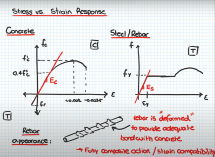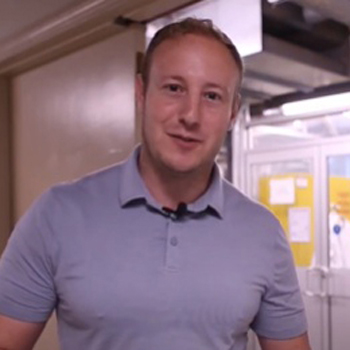When it became clear to Kyle Tousignant that he'd be moving his courses online this fall, the assistant professor in Dal's Faculty of Engineering looked to his past experiences with students for inspiration in plotting a path forward.
Dr. Tousignant’s goal was to make his mechanics course this fall feel as much like an in-person experience as possible by crafting high-quality video lab  demonstrations and lectures. The latter combined PowerPoint presentations and “chalk and talk,” shown right, where he uses a tablet computer to write and draw notes as he typically does in the classroom.
demonstrations and lectures. The latter combined PowerPoint presentations and “chalk and talk,” shown right, where he uses a tablet computer to write and draw notes as he typically does in the classroom.
“It’s a favoured approach,” he says.
Knowing that online learning can bring added difficulties for students, Dr. Tousignant also took special care to respect students’ time and workload when designing the course. That meant lab and lecture video were kept short and digestible.
“No effort was spared to ensure that lectures remained engaging,” he says.
Dr. Tousignant relied on a team of teaching assistants (TAs) to help him with the task of moving the lectures and labs online.
Accessibility and availability
To increase the clarity and excitement of the lab exercises, Dr. Tousignant and his team “set the bar high” on production value, bringing in multiple cameras, professional equipment and sharp editing. What’s more, Dr. Tousignant situated his real-life experiments in the Civil & Resource Engineering (CRE) department’s l aboratories on campus — further shaping the authenticity of the experience.
aboratories on campus — further shaping the authenticity of the experience.
TAs Alireza Siadat and Hayden Tackley worked "tirelessly" throughout the summer, helping to record and edit the lab demonstrations, says Dr. Tousignant, adding he could not have accomplished the shift without them.
Accessibility and a student-first approach were also paramount. For example, Dr. Tousignant's decision to host the videos on YouTube allowed them to be viewed with closed captioning and with the ability to be sped up or slowed down and replayed on-demand.
To complement the digital components of his course, Dr. Tousignant hosted weekly synchronous tutorials with recordings and office hours booked through Calendly — an idea shared with him by a fellow faculty member in the Rowe School of Business.
"I also drastically increased my general availability for emails and online meetings,” he says.
Dr. Tousignant's efforts have not gone unnoticed. Student feedback on the course delivery has been overwhelmingly positive, he says.

